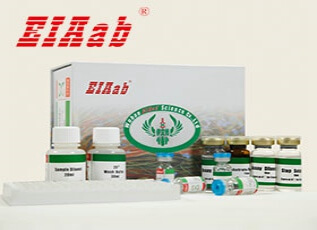Hmgb1 (基因名), High mobility group protein B1 (蛋白名), hmgb1_mouse.
产品名称:
Mouse Hmgb1/ High mobility group protein B1 CLIA Kit
高迁移率族蛋白B1
货号:
U0399m
商标:
EIAab®
监管等级:
别名:
High mobility group protein 1, HMG-1, Hmg-1, Hmg1
检测方法:
CLIA
实验类型:
Sandwich
检测范围:
0.195-125pg/mL
特异性:
Natural and recombinant mouse High mobility group protein B1
样品类型:
Serum, plasma, tissue homogenates, cell culture supernates and other biological fluids
样品数据:
登录.
研究领域:
Epigenetics
通用注释
亚单元:
Interacts (fully reduced HMGB1) with CXCL12; probably in a 1:2 ratio involving two molecules of CXCL12, each interacting with one HMG box of HMGB1; inhibited by glycyrrhizin (PubMed:22370717). Associates with the TLR4:LY96 receptor complex (By similarity). Component of the RAG complex composed of core components RAG1 and RAG2, and associated component HMGB1 or HMGB2 (PubMed:9184213). Interacts (in cytoplasm upon starvation) with BECN1; inhibits the interaction of BECN1 and BCL2 leading to promotion of autophagy (PubMed:20819940). Interacts with KPNA1; involved in nuclear import (PubMed:17114460). Interacts with SREBF1, TLR2, TLR4, TLR9, APEX1, FEN1, POLB, TERT (PubMed:16040616, PubMed:16267105, PubMed:17548579, PubMed:17803946, PubMed:22544226). Interacts with AGER, PTPRZ1, IL1B, MSH2, XPA, XPC, HNF1A, TP53 (By similarity). Interacts with CD24; the probable CD24:SIGLEC10 complex is proposed to inhibit HGMB1-mediated tissue damage immune response (PubMed:19264983). Interacts with THBD; prevents HGMB1 interaction with ACER/RAGE and inhibits HGMB1 proinflammatory activity (By similarity). Interacts with HAVCR2; impairs HMGB1 binding to B-DNA and likely HMGB1-mediated innate immume response (PubMed:22842346). Interacts with XPO1; mediating nuclear export.
功能:
In the extracellular compartment (following either active secretion or passive release) involved in regulation of the inflammatory response. Fully reduced HGMB1 (which subsequently gets oxidized after release) in association with CXCL12 mediates the recruitment of inflammatory cells during the initial phase of tissue injury; the CXCL12:HMGB1 complex triggers CXCR4 homodimerization (PubMed:22370717). Induces the migration of monocyte-derived immature dendritic cells and seems to regulate adhesive and migratory functions of neutrophils implicating AGER/RAGE and ITGAM (PubMed:17268551). Can bind to various types of DNA and RNA including microbial unmethylated CpG-DNA to enhance the innate immune response to nucleic acids. Proposed to act in promiscuous DNA/RNA sensing which cooperates with subsequent discriminative sensing by specific pattern recognition receptors (PubMed:19890330). Promotes extracellular DNA-induced AIM2 inflammasome activation implicating AGER/RAGE. Disulfide HMGB1 binds to transmembrane receptors, such as AGER/RAGE, TLR2, TLR4 and probably TREM1, thus activating their signal transduction pathways (PubMed:17568691, PubMed:19264983, PubMed:21419643). Mediates the release of cytokines/chemokines such as TNF, IL-1, IL-6, IL-8, CCL2, CCL3, CCL4 and CXCL10 (PubMed:12110890, PubMed:17548579). Promotes secretion of interferon-gamma by macrophage-stimulated natural killer (NK) cells in concert with other cytokines like IL-2 or IL-12. TLR4 is proposed to be the primary receptor promoting macrophage activation and signaling through TLR4 seems to implicate LY96/MD-2. In bacterial LPS- or LTA-mediated inflammatory responses binds to the endotoxins and transfers them to CD14 for signaling to the respective TLR4:LY96 and TLR2 complexes (By similarity). Contributes to tumor proliferation by association with ACER/RAGE (By similarity). Can bind to IL1-beta and signals through the IL1R1:IL1RAP receptor complex (By similarity). Binding to class A CpG activates cytokine production in plasmacytoid dendritic cells implicating TLR9, MYD88 and AGER/RAGE and can activate autoreactive B cells. Via HMGB1-containing chromatin immune complexes may also promote B cell responses to endogenous TLR9 ligands through a B-cell receptor (BCR)-dependent and ACER/RAGE-independent mechanism (By similarity). Inhibits phagocytosis of apoptotic cells by macrophages; the function is dependent on poly-ADP-ribosylation and involves binding to phosphatidylserine on the cell surface of apoptotic cells (PubMed:22204001, PubMed:18768881). In adaptive immunity may be involved in enhancing immunity through activation of effector T-cells and suppression of regulatory T (TReg) cells (PubMed:21419643). In contrast, without implicating effector or regulatory T-cells, required for tumor infiltration and activation of T-cells expressing the lymphotoxin LTA:LTB heterotrimer thus promoting tumor malignant progression (PubMed:23108142). Also reported to limit proliferation of T-cells (By similarity). Released HMGB1:nucleosome complexes formed during apoptosis can signal through TLR2 to induce cytokine production (By similarity). Involved in induction of immunological tolerance by apoptotic cells; its pro-inflammatory activities when released by apoptotic cells are neutralized by reactive oxygen species (ROS)-dependent oxidation specifically on Cys-106 (By similarity). During macrophage activation by activated lymphocyte-derived self apoptotic DNA (ALD-DNA) promotes recruitment of ALD-DNA to endosomes (PubMed:25660970).
亚细胞位置:
Nucleus
Cytoplasm
Secreted
Chromosome
Cell membrane
Peripheral membrane protein
Extracellular side
Endosome
Endoplasmic reticulum-Golgi intermediate compartment
In basal state predominantly nuclear. Shuttles between the cytoplasm and the nucleus (PubMed:17114460). Translocates from the nucleus to the cytoplasm upon autophagy stimulation (PubMed:20819940). Release from macrophages in the extracellular milieu requires the activation of NLRC4 or NLRP3 inflammasomes (PubMed:20802146). Passively released to the extracellular milieu from necrotic cells by diffusion, involving the fully reduced form which subsequently gets oxidized (PubMed:12110890). Also released from apoptic cells (PubMed:25660970). Actively secreted from a variety of immune and non-immune cells such as macrophages, monocytes, neutrophils, dendritic cells and natural killer cells in response to various stimuli, involving a nonconventional secretory process via secretory lysosomes (PubMed:17548579). Secreted by plasma cells in response to LPS (PubMed:21319304). Associated with the plasma membrane of filipodia in process-growing cells, and also deposited into the substrate-attached material (By similarity). Colocalizes with DDX58 on endosomal membranes (PubMed:19890330).
数据库链接
UniGene:
SMR:
STRING:
KEGG:
Pfam:
Uniprot:
[1].
[3].
反馈墙
评论数 : 0
所有用户
所有用户
默认排序
默认排序
最近
早期
目前还没有评论。






通知
规格
数量
单价 (¥)
小计 1 (¥)
小计 2:
¥

规格
数量
单价 (¥)










 验证序列:
验证序列:




 折扣:
折扣: